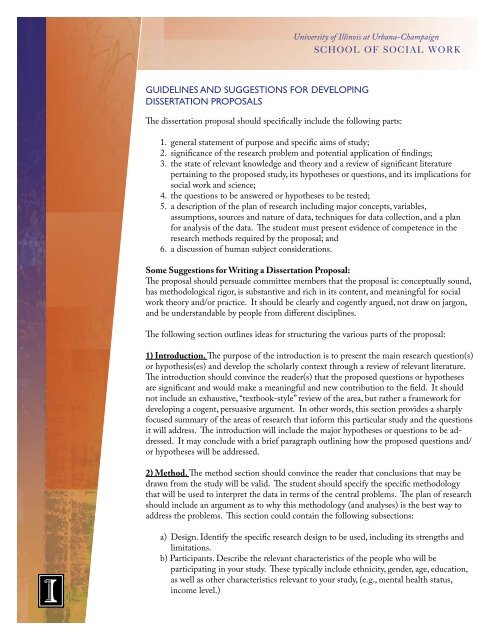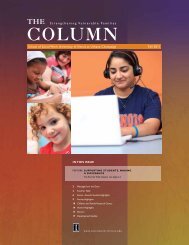guidelines and suggestions for developing dissertation proposals
guidelines and suggestions for developing dissertation proposals
guidelines and suggestions for developing dissertation proposals
You also want an ePaper? Increase the reach of your titles
YUMPU automatically turns print PDFs into web optimized ePapers that Google loves.
Guidelines <strong>and</strong> suGGestions <strong>for</strong> developinG<br />
<strong>dissertation</strong> <strong>proposals</strong><br />
University of Illinois at Urbana-Champaign<br />
School of Social Work<br />
The <strong>dissertation</strong> proposal should specifically include the following parts:<br />
1. general statement of purpose <strong>and</strong> specific aims of study;<br />
2. significance of the research problem <strong>and</strong> potential application of findings;<br />
3. the state of relevant knowledge <strong>and</strong> theory <strong>and</strong> a review of significant literature<br />
pertaining to the proposed study, its hypotheses or questions, <strong>and</strong> its implications <strong>for</strong><br />
social work <strong>and</strong> science;<br />
4. the questions to be answered or hypotheses to be tested;<br />
5. a description of the plan of research including major concepts, variables,<br />
assumptions, sources <strong>and</strong> nature of data, techniques <strong>for</strong> data collection, <strong>and</strong> a plan<br />
<strong>for</strong> analysis of the data. The student must present evidence of competence in the<br />
research methods required by the proposal; <strong>and</strong><br />
6. a discussion of human subject considerations.<br />
Some Suggestions <strong>for</strong> Writing a Dissertation Proposal:<br />
The proposal should persuade committee members that the proposal is: conceptually sound,<br />
has methodological rigor, is substantive <strong>and</strong> rich in its content, <strong>and</strong> meaningful <strong>for</strong> social<br />
work theory <strong>and</strong>/or practice. It should be clearly <strong>and</strong> cogently argued, not draw on jargon,<br />
<strong>and</strong> be underst<strong>and</strong>able by people from different disciplines.<br />
The following section outlines ideas <strong>for</strong> structuring the various parts of the proposal:<br />
1) Introduction. The purpose of the introduction is to present the main research question(s)<br />
or hypothesis(es) <strong>and</strong> develop the scholarly context through a review of relevant literature.<br />
The introduction should convince the reader(s) that the proposed questions or hypotheses<br />
are significant <strong>and</strong> would make a meaningful <strong>and</strong> new contribution to the field. It should<br />
not include an exhaustive, “textbook-style” review of the area, but rather a framework <strong>for</strong><br />
<strong>developing</strong> a cogent, persuasive argument. In other words, this section provides a sharply<br />
focused summary of the areas of research that in<strong>for</strong>m this particular study <strong>and</strong> the questions<br />
it will address. The introduction will include the major hypotheses or questions to be addressed.<br />
It may conclude with a brief paragraph outlining how the proposed questions <strong>and</strong>/<br />
or hypotheses will be addressed.<br />
2) Method. The method section should convince the reader that conclusions that may be<br />
drawn from the study will be valid. The student should specify the specific methodology<br />
that will be used to interpret the data in terms of the central problems. The plan of research<br />
should include an argument as to why this methodology (<strong>and</strong> analyses) is the best way to<br />
address the problems. This section could contain the following subsections:<br />
a) Design. Identify the specific research design to be used, including its strengths <strong>and</strong><br />
limitations.<br />
b) Participants. Describe the relevant characteristics of the people who will be<br />
participating in your study. These typically include ethnicity, gender, age, education,<br />
as well as other characteristics relevant to your study, (e.g., mental health status,<br />
income level.)
c) Procedures. Describe exactly what you propose to do in enough detail that committee members can assess the<br />
adequacy of your methods <strong>for</strong> addressing your question.<br />
d) Human Subjects. When human subjects are involved, all <strong>proposals</strong> must abide by the School <strong>and</strong> University<br />
<strong>guidelines</strong> on the use of human subjects in research. The website <strong>for</strong> UIUC Institutional Review Board, which<br />
h<strong>and</strong>les human subjects requests <strong>and</strong> issues, is: http://irb.illinois.edu/. Procedures to be followed in this respect<br />
should be elaborated in the proposal.<br />
3) Analysis. Describe the analytic procedures you will employ to interpret the data used. Other relevant topics, depending<br />
on the discussion topic <strong>and</strong> the methods used, would be data management <strong>and</strong> reduction.<br />
4) Discussion/Conclusion. This section should include a summary discussion of the possible significance of your findings<br />
to social work policy <strong>and</strong>/or practice, <strong>and</strong> its relevance to possible future research (that is, describe how the proposed study<br />
fits into a larger research program). The section might also consider <strong>and</strong> explore alternate interpretations/explanations, as<br />
well as limitations to the study. It will also underscore what will be learned as a result of the study that is not known now.<br />
5) References. Use APA Style (See most recent available version of APA publication manual).<br />
The following readings may be useful in preparing your proposal:<br />
Publication Manual of the American Psychological Association: Fifth Edition (2001). American Psychological<br />
Association.<br />
Shadish, W., Cook, T., & Campbell, D. (2002). Experimental <strong>and</strong> quasiexperimental designs <strong>for</strong> generalized causal<br />
inference. Boston, MA: Houghton Mifflin Company.<br />
Przeworski, A. & Salomon, F. (1995). The Art of Writing Proposals: Some C<strong>and</strong>id Suggestions <strong>for</strong> Applicants to Social<br />
Science Research Council. Retrieved November 19, 2003, from<br />
http://www.ssrc.org/cgi-bin/htsearch?workds=The+Art+of+Writing+Proposals.



